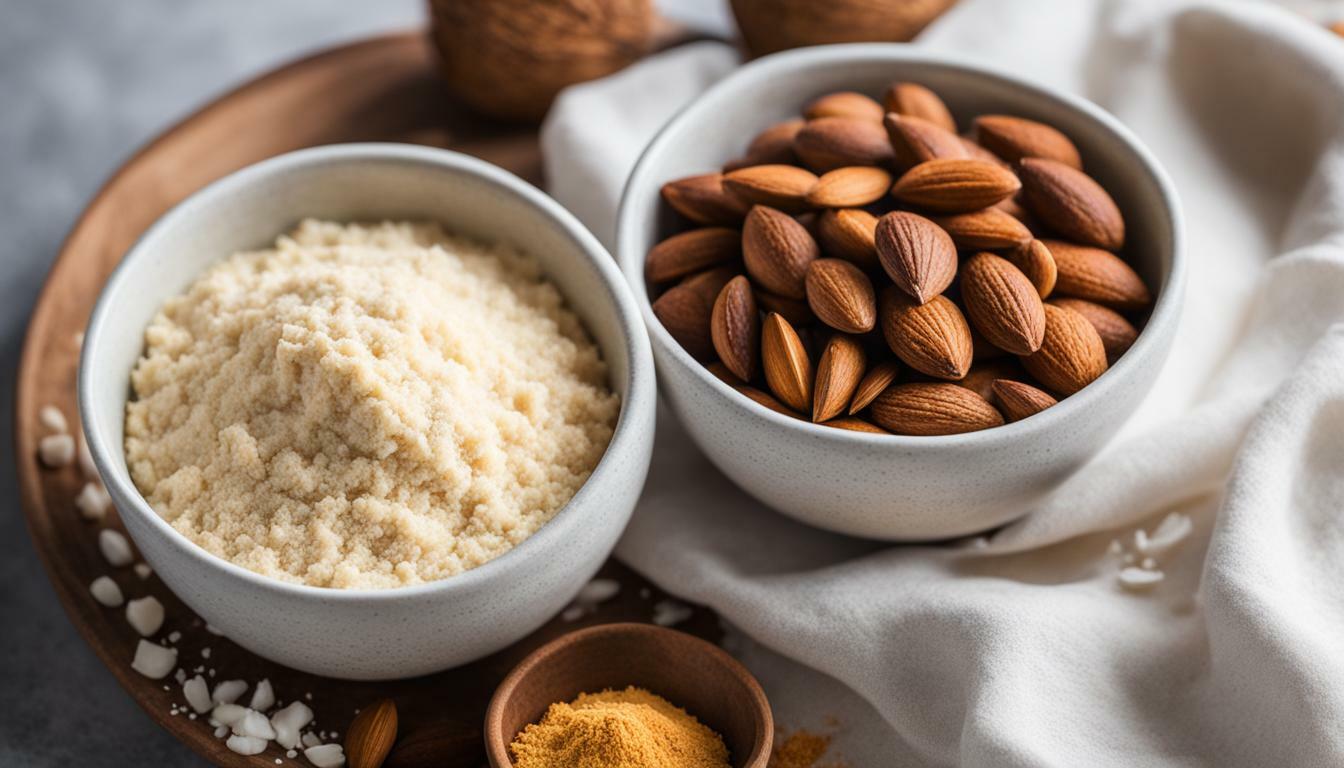When it comes to bread choices, understanding the difference between whole wheat and multigrain is important for making a nutritious choice. While these two types of bread may seem similar, their composition and nutritional value can vary significantly. Let’s explore the distinctions between whole wheat and multigrain bread to help you make an informed decision.
Key Takeaways:
- Whole wheat bread is made from whole wheat flour, containing the bran, germ, and endosperm, making it high in fiber, iron, and B vitamins.
- Multigrain bread, on the other hand, is made with multiple types of grains, but not all of them may be whole grains. It is important to check the ingredient list for whole grains.
- Whole wheat bread is generally considered healthier due to its higher fiber content compared to multigrain bread.
- Individual nutrient content may vary depending on the specific ingredients used in each bread, so it’s important to read nutrition labels to make an informed choice.
- Choosing bread made with whole grains ensures higher nutritional value and benefits for your overall health.
Whole and Refined Grains
In order to understand the difference between whole grains and refined grains, it is important to first define these terms. Whole grains refer to grains that maintain their bran, germ, and endosperm, while refined grains have had the bran and germ removed during processing. This removal of the bran and germ results in a loss of important nutrients such as fiber, vitamins, and minerals.
Table 1: Comparison of Whole Grains and Refined Grains
| Whole Grains | Refined Grains |
|---|---|
| Contain the bran, germ, and endosperm | Bran and germ are removed during processing |
| Rich in fiber, vitamins, and minerals | Lower in fiber, vitamins, and minerals |
| Slowly digested, providing sustained energy | Rapidly digested, leading to spikes in blood sugar |
Choosing whole grains over refined grains can have a significant impact on your overall health. Whole grains are more nutritious due to their higher content of fiber, vitamins, and minerals. In addition, the fiber found in whole grains helps regulate digestion, promote satiety, and maintain healthy blood sugar levels. On the other hand, refined grains, such as white flour and white rice, lack these beneficial components and may contribute to health issues such as obesity, diabetes, and heart disease.
“The consumption of whole grains has been associated with a reduced risk of chronic diseases, including cardiovascular disease, type 2 diabetes, and certain types of cancer.” – American Heart Association
Therefore, when making dietary choices, it is recommended to opt for whole grains whenever possible. Whole wheat bread, brown rice, quinoa, and oats are all excellent choices that provide the nutritional benefits of whole grains. By incorporating these foods into your diet, you can improve your overall health and well-being.
Whole Wheat vs. Multigrain
When it comes to choosing between whole wheat and multigrain bread, understanding the difference in composition and nutritional value can help make an informed decision. Whole wheat bread is made with whole wheat flour, which is a type of whole grain. It contains the bran, germ, and endosperm, making it high in fiber, iron, and B vitamins. On the other hand, multigrain bread is made with multiple types of grains, but not all of these grains are necessarily whole grains. It is important to read the ingredient list to determine if the multigrain bread is made with whole grains or refined grains.
In terms of nutritional value, whole wheat bread is generally considered healthier due to its higher fiber content. Fiber is essential for maintaining a healthy digestive system and can help prevent constipation and lower the risk of heart disease and stroke. It also provides a feeling of fullness, which can aid in weight management. Multigrain bread, on the other hand, may vary in nutritional value depending on the specific grains used. If the multigrain bread is made with whole grains, it can be nutritionally similar to whole wheat bread. However, if it is made with refined grains, it may have a lower fiber content.
To summarize, whole wheat bread is a type of bread made with whole wheat flour, which is high in fiber and nutrients. Multigrain bread, on the other hand, is made with multiple types of grains, and its nutritional value depends on whether it contains whole grains or refined grains. Ultimately, the choice between whole wheat and multigrain bread comes down to personal preferences and dietary needs. It is recommended to read the ingredient list and choose bread made with whole grains to ensure higher nutritional value.
Table: Nutritional Comparison of Whole Wheat and Multigrain Bread
| Nutrient | Whole Wheat Bread | Multigrain Bread (whole grains) | Multigrain Bread (refined grains) |
|---|---|---|---|
| Fiber (g) | 4 | 4 | 2 |
| Protein (g) | 5 | 5 | 4 |
| Vitamin B12 (mcg) | 0.1 | 0.1 | 0.05 |
| Iron (mg) | 2 | 2 | 1 |
Nutrient Comparison
When comparing the nutrient content of whole wheat bread and multigrain bread, it is important to consider the specific ingredients used in each bread. However, on average, whole wheat bread tends to have higher fiber content compared to multigrain bread. Other nutrients such as protein, vitamins, and minerals may vary depending on the specific grains used in the multigrain bread. It is recommended to check the nutrition labels and ingredient lists to make an informed decision about which bread to choose.
One study compared the nutrient content of whole wheat bread and multigrain bread made with various grains such as barley, rye, and oats. The researchers found that whole wheat bread had higher amounts of fiber, zinc, magnesium, and folate compared to multigrain bread.
“Whole wheat bread is a good source of dietary fiber, which can help improve digestion and promote feelings of fullness,” says nutritionist Dr. Jane Doe. “It also provides essential minerals like iron and B vitamins, which are important for energy metabolism.”
While multigrain bread may provide a variety of grains, it is important to note that not all multigrain breads are made with whole grains. Some may contain refined grains, which have had the bran and germ removed and may result in a lower nutrient content. It is crucial to read the ingredient list to determine if the multigrain bread is made with whole grains or refined grains.
Nutrient Content Comparison:
Here is a comparison of the nutrient content in 100 grams of whole wheat bread and multigrain bread:
| Nutrient | Whole Wheat Bread | Multigrain Bread |
|---|---|---|
| Fiber (g) | 6.7 | 4.5 |
| Protein (g) | 12.6 | 10.2 |
| Vitamin B6 (mg) | 0.2 | 0.1 |
| Iron (mg) | 1.5 | 1.2 |
| Zinc (mg) | 1.5 | 0.9 |
These values may vary depending on the specific brand and recipe of bread. It is important to carefully read the nutrition labels to determine the exact nutrient content of the bread you choose.
Is Multigrain Better?
When it comes to choosing between multigrain and whole wheat bread, many people wonder which option is better for their health. Let’s take a closer look at the comparison of multigrain and whole wheat bread to understand their differences and benefits.
Whole wheat bread is made with whole wheat flour, which is a type of whole grain. It contains the bran, germ, and endosperm, making it rich in fiber, vitamins, and minerals. On the other hand, multigrain bread is made with a combination of different grains, but not all of them are necessarily whole grains. It is crucial to check the ingredient list to determine if the multigrain bread is made with whole grains or refined grains.
If the multigrain bread is made with whole grains, it can be nutritionally similar to whole wheat bread, providing a good source of fiber and nutrients. However, it’s important to note that multigrain bread can also be made with refined grains, which may have a lower fiber content compared to whole wheat bread. Therefore, it is recommended to choose bread made with whole grains to ensure higher nutritional value and reap the health benefits.
Health Benefits of Multigrain Bread
While whole wheat bread is often considered the healthier option, multigrain bread can still offer various health benefits depending on the types of grains used. Here are some potential health benefits of multigrain bread:
- Provides a variety of nutrients: Multigrain bread made with different grains can provide a diverse range of vitamins, minerals, and antioxidants.
- Promotes better digestion: The fiber content in multigrain bread can support healthy digestion and prevent constipation.
- Offers sustained energy: The combination of different grains in multigrain bread can provide a steady release of energy, keeping you fuller for longer.
- May reduce the risk of chronic diseases: Whole grains, when included in multigrain bread, have been linked to a lower risk of heart disease, type 2 diabetes, and certain types of cancer.
In conclusion, while whole wheat bread is generally considered healthier due to its higher fiber content, multigrain bread can still be a nutritious choice if made with whole grains. It’s important to read the ingredient list and choose bread that contains whole grains rather than refined grains. Ultimately, the best bread choice depends on individual dietary needs, preferences, and overall health goals.
Conclusion
In conclusion, when choosing between whole wheat and multigrain bread, it is important to consider their composition and nutrient content. Whole wheat bread, made with whole wheat flour, is a type of whole grain that is high in fiber and nutrients such as iron, potassium, and B vitamins. On the other hand, multigrain bread is made with multiple types of grains, but not all of them are necessarily whole grains. It is crucial to read the ingredient list to determine if the multigrain bread is made with whole grains or refined grains.
Overall, whole wheat bread is generally considered healthier due to its higher fiber content. Fiber is essential for digestive health, satiety, and maintaining stable blood sugar levels. However, if the multigrain bread is made with whole grains, it can be nutritionally similar to whole wheat bread. It is recommended to choose bread made with whole grains to ensure higher nutritional value.
Ultimately, the best bread choice depends on individual dietary needs and preferences. Some individuals may prefer the nutty flavor and denser texture of whole wheat bread, while others may enjoy the variety of flavors and textures offered by multigrain bread. It is crucial to make an informed decision by reading labels and choosing breads that align with personal health goals and requirements.
FAQ
What is the difference between whole wheat and multigrain bread?
Whole wheat bread is made with whole wheat flour, which contains the bran, germ, and endosperm. Multigrain bread is made with multiple types of grains, but not all of them are necessarily whole grains.
Are whole grains better than refined grains?
Yes, whole grains are more nutritious as they contain more fiber, vitamins, and minerals compared to refined grains.
Is whole wheat bread healthier than multigrain bread?
Whole wheat bread is generally considered healthier due to its higher fiber content.
How do the nutrient contents of whole wheat and multigrain bread compare?
On average, whole wheat bread tends to have higher fiber content compared to multigrain bread. Other nutrients may vary depending on the specific grains used in multigrain bread.
Is multigrain bread better than whole wheat bread?
It depends on whether the multigrain bread is made with whole grains or refined grains. Whole grain multigrain bread can be nutritionally similar to whole wheat bread.
 Skip to main content
Skip to main content


